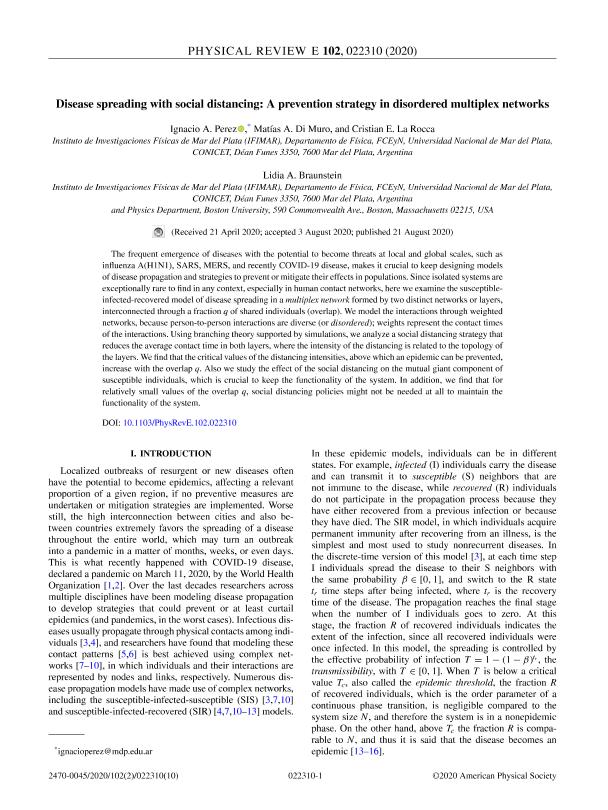Artículo
Disease spreading with social distancing: A prevention strategy in disordered multiplex networks
Pérez, Ignacio Augusto ; Di Muro, Matias Alberto
; Di Muro, Matias Alberto ; la Rocca, Cristian Ernesto
; la Rocca, Cristian Ernesto ; Braunstein, Lidia Adriana
; Braunstein, Lidia Adriana
 ; Di Muro, Matias Alberto
; Di Muro, Matias Alberto ; la Rocca, Cristian Ernesto
; la Rocca, Cristian Ernesto ; Braunstein, Lidia Adriana
; Braunstein, Lidia Adriana
Fecha de publicación:
08/2020
Editorial:
American Physical Society
Revista:
Physical Review E
ISSN:
2470-0045
e-ISSN:
2470-0053
Idioma:
Inglés
Tipo de recurso:
Artículo publicado
Clasificación temática:
Resumen
The frequent emergence of diseases with the potential to become threats at local and global scales, such as influenza A(H1N1), SARS, MERS, and recently COVID-19 disease, makes it crucial to keep designing models of disease propagation and strategies to prevent or mitigate their effects in populations. Since isolated systems are exceptionally rare to find in any context, especially in human contact networks, here we examine the susceptible-infected-recovered model of disease spreading in a multiplex network formed by two distinct networks or layers, interconnected through a fraction q of shared individuals (overlap). We model the interactions through weighted networks, because person-to-person interactions are diverse (or disordered); weights represent the contact times of the interactions. Using branching theory supported by simulations, we analyze a social distancing strategy that reduces the average contact time in both layers, where the intensity of the distancing is related to the topology of the layers. We find that the critical values of the distancing intensities, above which an epidemic can be prevented, increase with the overlap q. Also we study the effect of the social distancing on the mutual giant component of susceptible individuals, which is crucial to keep the functionality of the system. In addition, we find that for relatively small values of the overlap q, social distancing policies might not be needed at all to maintain the functionality of the system.
Palabras clave:
COMPLEX NETWORKS
,
EPIDEMIC MODELS
,
GENERATING FUNCTIONS
Archivos asociados
Licencia
Identificadores
Colecciones
Articulos(IFIMAR)
Articulos de INST.DE INVESTIGACIONES FISICAS DE MAR DEL PLATA
Articulos de INST.DE INVESTIGACIONES FISICAS DE MAR DEL PLATA
Citación
Pérez, Ignacio Augusto; Di Muro, Matias Alberto; la Rocca, Cristian Ernesto; Braunstein, Lidia Adriana; Disease spreading with social distancing: A prevention strategy in disordered multiplex networks; American Physical Society; Physical Review E; 102; 2; 8-2020; 1-10
Compartir
Altmétricas



